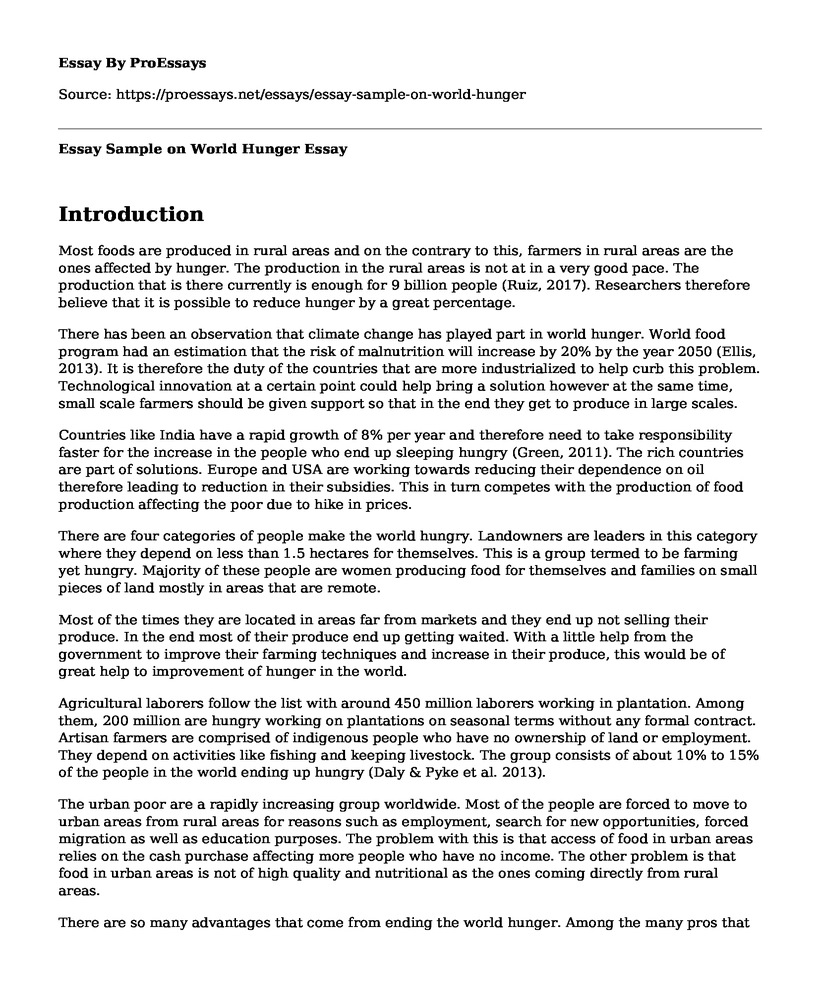Introduction
Most foods are produced in rural areas and on the contrary to this, farmers in rural areas are the ones affected by hunger. The production in the rural areas is not at in a very good pace. The production that is there currently is enough for 9 billion people (Ruiz, 2017). Researchers therefore believe that it is possible to reduce hunger by a great percentage.
There has been an observation that climate change has played part in world hunger. World food program had an estimation that the risk of malnutrition will increase by 20% by the year 2050 (Ellis, 2013). It is therefore the duty of the countries that are more industrialized to help curb this problem. Technological innovation at a certain point could help bring a solution however at the same time, small scale farmers should be given support so that in the end they get to produce in large scales.
Countries like India have a rapid growth of 8% per year and therefore need to take responsibility faster for the increase in the people who end up sleeping hungry (Green, 2011). The rich countries are part of solutions. Europe and USA are working towards reducing their dependence on oil therefore leading to reduction in their subsidies. This in turn competes with the production of food production affecting the poor due to hike in prices.
There are four categories of people make the world hungry. Landowners are leaders in this category where they depend on less than 1.5 hectares for themselves. This is a group termed to be farming yet hungry. Majority of these people are women producing food for themselves and families on small pieces of land mostly in areas that are remote.
Most of the times they are located in areas far from markets and they end up not selling their produce. In the end most of their produce end up getting waited. With a little help from the government to improve their farming techniques and increase in their produce, this would be of great help to improvement of hunger in the world.
Agricultural laborers follow the list with around 450 million laborers working in plantation. Among them, 200 million are hungry working on plantations on seasonal terms without any formal contract. Artisan farmers are comprised of indigenous people who have no ownership of land or employment. They depend on activities like fishing and keeping livestock. The group consists of about 10% to 15% of the people in the world ending up hungry (Daly & Pyke et al. 2013).
The urban poor are a rapidly increasing group worldwide. Most of the people are forced to move to urban areas from rural areas for reasons such as employment, search for new opportunities, forced migration as well as education purposes. The problem with this is that access of food in urban areas relies on the cash purchase affecting more people who have no income. The other problem is that food in urban areas is not of high quality and nutritional as the ones coming directly from rural areas.
There are so many advantages that come from ending the world hunger. Among the many pros that come from it includes the fact that it can help reduce the level of poverty in underdeveloped countries. According to study, if rich countries work hand in hand with each other, then this can aid solve the hunger problem. They can do this through training on better farming methods, equality among countries as well as assistance in their medical state.
Giving foreign aid is a good option to help reduce the level of poverty in poor countries. This in turn gets to benefit the donor as well as the recipient. This is because through the interaction of helping, good relations are created between the two countries. As much as rich countries might seem to have it all, there might be a certain point where the rich country needs their help. Helping other countries helps in encouraging them to be more independent in times to come.
The drawback to foreign aid is that due to the increase in corruption in the world, foreign aid ends up no going to the people it was intended for. Poor countries especially those with officials who are corrupt end up using their aid to their own benefit or for those who need it the least. Critics say that at times foreign aid is given to countries that can in return be beneficial to the donor instead of countries that are in dire need of the help.
Conclusion
The other drawback to foreign aid is that when rich countries help poor countries by giving them loans, is that they end up with big debts which in the end might be difficult for them to pay. In the end they become poorer that they were due to debts.
Reference List
Green, D. (2012, Feb 15th). Ending world hunger is possible- so why hasn't it been done? Retrieved from www.the guardian.com
Ellis, E.C. (2013, Sept 13th). Overpopulation is not the problem. Retrieved from nytimes.com
Schaeffer, U. (2011, October 31st). Hunger is a political problem. Retrieved from m.dw.com
Daly, T., Pyke, T., Regan, C., Regan, C. (2013, Nov 1st). Debating world hunger. Retrieved from developmenteducation.ie
Cite this page
Essay Sample on World Hunger. (2022, Nov 21). Retrieved from https://proessays.net/essays/essay-sample-on-world-hunger
If you are the original author of this essay and no longer wish to have it published on the ProEssays website, please click below to request its removal:
- The Need for Environment Conservation - A Research Paper on Ecology
- Digital Media Ethics and Technology on Climate Change Essay
- Annotated Bibliography on the Issue of Climate Change
- Essay Example on Tech Advances: Sustainable Growth or Unsustainable Destruction?
- Our Moral Obligation to Future Generations in Reigning in Global Warming and its Negative Effects
- Essay Sample on Plastic Pollution Crisis: A Threat to the Environment
- Article Analysis Essay on Wastewater Reuse for Irrigation: Nutrient Recovery & Waste Disposal







